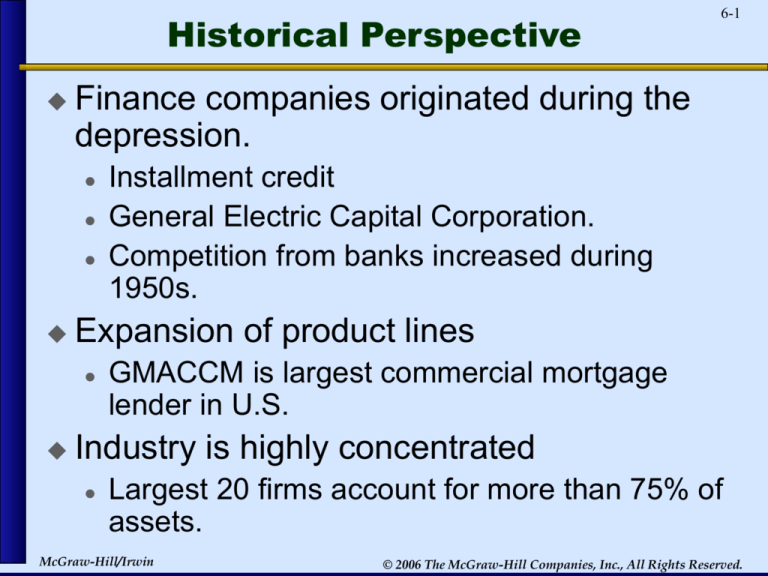
Historical Perspective
Finance companies originated during the
depression.
Installment credit
General Electric Capital Corporation.
Competition from banks increased during
1950s.
Expansion of product lines
6-1
GMACCM is largest commercial mortgage
lender in U.S.
Industry is highly concentrated
Largest 20 firms account for more than 75% of
assets.
McGraw-Hill/Irwin
© 2006 The McGraw-Hill Companies, Inc., All Rights Reserved.
Finance Companies
6-2
Activities similar to banks, but no depository
function.
May specialize in installment loans (e.g.
automobile loans) or may be diversified,
providing consumer loans and financing to
corporations, especially through factoring.
Commercial paper is key source of funds.
Captive Finance Companies: e.g. GMAC
McGraw-Hill/Irwin
© 2006 The McGraw-Hill Companies, Inc., All Rights Reserved.
Major Types of Finance Companies
Personal credit institutions
Household International Corp. and AIG
American General
Sales finance institutions
6-3
Ford Motor Credit and Sears Roebuck
Acceptance Corp.
Business credit institutions
CIT Group and Fleet Boston Financial.
Equipment leasing and factoring.
McGraw-Hill/Irwin
© 2006 The McGraw-Hill Companies, Inc., All Rights Reserved.
Largest Finance Companies
6-4
Company Name
Total Assets
(Millions)
General Electric Capital
Services
$233,086
Ford Motor Credit Company
202,528
Citigroup
130,400
Household International, Inc.
107,496
MBNA Corp.
107,258
McGraw-Hill/Irwin
© 2006 The McGraw-Hill Companies, Inc., All Rights Reserved.
Balance Sheet and Trends
6-5
Business and consumer loans are the major
assets
51.9% of total assets, 2003.
Reduced from 95.1% in 1977.
Increases in real estate loans and other
assets.
Growth in leasing (largely due to tax
incentives of 1981 Economic Recovery Act).
Finance companies face credit risk, interest
rate risk and liquidity risk.
McGraw-Hill/Irwin
© 2006 The McGraw-Hill Companies, Inc., All Rights Reserved.
Balance Sheet and Trends
6-6
Consumer loans
Primarily motor vehicle loans and leases.
Recent low auto finance company rates are
anomalous—partly due to 9/11 effects.
Attempts to boost new vehicle sales via 0.0% loans
lasted into 2004.
By 2003, rates 3.5% lower than banks on new
vehicle rates
McGraw-Hill/Irwin
© 2006 The McGraw-Hill Companies, Inc., All Rights Reserved.
Consumer loans (continued)
6-7
Generally riskier customers than banks
serve.
Subprime mortgage lenders
Jayhawk Acceptance Corp.
From auto loans to tummy tucks and nose jobs
Increase in “loan shark” firms with rates as
high as 30% or more.
Other consumer loans about 24.7% of
consumer loan portfolio, 2003.
McGraw-Hill/Irwin
© 2006 The McGraw-Hill Companies, Inc., All Rights Reserved.
Balance Sheet and Trends
6-8
Mortgages
Recent addition to finance company assets
Smaller regulatory burden than banks
May be direct mortgages, or as securitized
mortgage assets.
Growth in home equity loans since passage of
Tax Reform Act of 1986.
Tax deductibility issue.
Conversion of credit card debt
2003 average home equity loan $69,513
McGraw-Hill/Irwin
© 2006 The McGraw-Hill Companies, Inc., All Rights Reserved.
Business Loans
6-9
Business loans comprise largest portion of
finance company loans.
Advantages over commercial banks:
Fewer regulatory impediments to types of
products and services.
Not depository institutions hence less regulatory
scrutiny and lower overheads.
Often have substantial expertise and greater
willingness to accept riskier clients.
McGraw-Hill/Irwin
© 2006 The McGraw-Hill Companies, Inc., All Rights Reserved.
Business Loans
6-10
Major subcategories:
Retail and wholesale motor vehicle loans and
leases
Equipment loans
tax issues associated when finance company leases
the equipment directly to the customer
Other business loans and securitized business
assets
McGraw-Hill/Irwin
© 2006 The McGraw-Hill Companies, Inc., All Rights Reserved.
Liabilities
6-11
Major liabilities: commercial paper and other
debt (longer-term notes and bonds).
Finance firms are largest issuers of
commercial paper (frequently through direct
sale programs).
Commercial paper maturities up to 270 days.
Consequently, management of liquidity risk
differs from commercial banks relying on
deposits
McGraw-Hill/Irwin
© 2006 The McGraw-Hill Companies, Inc., All Rights Reserved.
Industry Performance
6-12
Strong loan demand
Strong profits for the largest firms
e.g. Household International, Associates First
Capital, Beneficial
Effects of low interest rates
Most successful have become takeover
targets
Citigroup/Associates First Capital,
Household International/HSBC Holdings
McGraw-Hill/Irwin
© 2006 The McGraw-Hill Companies, Inc., All Rights Reserved.
Industry Performance
6-13
High risk has a downside:
Subprime lending: Jayhawk Acceptance
Corporation
Cityscape Financial Corp., Aames Financial
Corp., Advanta, FirstPlus Financial Group, The
Money Store, Associates First Capital
FTC scrutiny of subprime lending practices
violating Truth in Lending Act, Fair Credit
Reporting Act, Equal Opportunity Act
2002, Citigroup $200 million settlement for
predatory lending via Associates First Capital
McGraw-Hill/Irwin
© 2006 The McGraw-Hill Companies, Inc., All Rights Reserved.
Electronic Lending
6-14
Mainly mortgages completed over the
Internet
E-Loan
Suffered with the dot-com downturn
McGraw-Hill/Irwin
© 2006 The McGraw-Hill Companies, Inc., All Rights Reserved.
Regulation of Finance Companies
6-15
Federal Reserve definition of Finance
Company
Firm, other than depository institution, whose
primary assets are loans to individuals and
businesses.
Subject to state-imposed usury ceilings.
Much lower regulatory burden than
depository institutions.
Not subject to Community Reinvestment Act.
Lack the banks’ regulatory safety-net
McGraw-Hill/Irwin
© 2006 The McGraw-Hill Companies, Inc., All Rights Reserved.
Regulation
6-16
With less regulatory scrutiny, finance
companies must signal safety and
soundness to capital markets in order to
obtain funds.
Lower leverage than banks (15.1% capitalassets versus 9.1% for commercial banks).
Captive finance companies may employ
default protection guarantees from parent
company or other protection such as letters
of credit.
McGraw-Hill/Irwin
© 2006 The McGraw-Hill Companies, Inc., All Rights Reserved.






